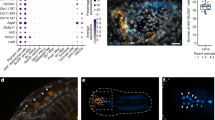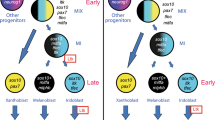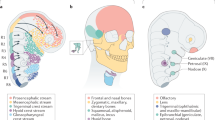Abstract
The neural crest, a source of many different cell types in vertebrate embryos, has not been identified in other chordates1,2,3. Current opinion therefore holds that neural crest cells were a vertebrate innovation4,5,6,7. Here we describe a migratory cell population resembling neural crest cells in the ascidian urochordate Ecteinascidia turbinata. Labelling of embryos and larvae with the vital lipophilic dye DiI enabled us to detect cells that emerge from the neural tube, migrate into the body wall and siphon primordia, and subsequently differentiate as pigment cells. These cells express HNK-1 antigen and Zic gene markers of vertebrate neural crest cells. The results suggest that migratory cells with some of the features of neural crest cells are present in the urochordates. Thus, we propose a hypothesis for neural crest evolution beginning with the release of migratory cells from the CNS to produce body pigmentation in the common ancestor of the urochordates and vertebrates. These cells may have gained additional functions or were joined by other cell types to generate the variety of derivatives typical of the vertebrate neural crest.
This is a preview of subscription content, access via your institution
Access options
Subscribe to this journal
Receive 51 print issues and online access
$199.00 per year
only $3.90 per issue
Buy this article
- Purchase on SpringerLink
- Instant access to full article PDF
Prices may be subject to local taxes which are calculated during checkout




Similar content being viewed by others
References
Hall, B. K. The Neural Crest in Development and Evolution (Springer, New York, 1999)
Le Douarin, N. & Kalcheim, C. The Neural Crest 2nd edn (Cambridge Univ., Cambridge, 1999)
Baker, C. V. H. & Bronner-Fraser, M. The origins of the neural crest. Part II: an evolutionary perspective. Mech. Dev. 69, 13–29 (1997)
Gans, C. & Northcutt, R. G. Neural crest and the origin of vertebrates: a new head. Science 220, 268–274 (1983)
Shimeld, S. M. & Holland, P. W. H. Vertebrate innovations. Proc. Natl Acad. Sci. USA 97, 4449–4452 (2000)
Wada, H. Origin and evolution of the neural crest: A hypothetical reconstruction of its evolutionary history. Dev. Growth Diff. 43, 509–520 (2001)
Stone, J. R. & Hall, B. K. Latent homologues of the neural crest as an evolutionary novelty. Evol. Dev. 6, 123–129 (2004)
Corbo, J. C., Erives, A., DiGregorio, A. & Levine, M. Dorsoventral patterning of the vertebrate neural tube is conserved in a protochordate. Development 124, 2335–2344 (1997)
Langeland, J. A., Tomsa, J. M., Jackman, W. R. & Kimmel, C. B. An amphioxus snail gene: Expression in paraxial mesoderm and neural plate suggests a conserved role in patterning the chordate embryo. Dev. Genes Evol. 208, 569–577 (1998)
Holland, L. Z. & Holland, N. D. Evolution of the neural crest and placodes: amphioxus as a model system. J. Anat. 199, 85–98 (2001)
Jeffery, W. R. & Swalla, B. J. Evolution of alternate modes of development in ascidians. BioEssays 14, 219–226 (1992)
Berrill, N. J. Studies in tunicate development. III. Differential retardation and acceleration. Phil. Trans. R. Soc. Lond. B 225, 255–326 (1935)
Lyerla, T. A., Lyerla, J. H. & Fisher, M. Pigmentation in the orange tunicate Ecteinascidia turbinata. Biol. Bull. 149, 178–185 (1975)
Thiery, J.-P., Duband, J. L. & Dolouvée, A. Pathways and mechanisms of avian trunk neural crest cell migration and localization. Dev. Biol. 93, 324–343 (1982)
Jungalwala, F. B., Chou, D. K. H., Suzuki, Y. & Maxwell, G. D. Temporal expression of HNK-1 reactive sulfoglucuronyl glycolipid in cultured quail trunk neural crest cells—comparison with other developmental regulated glycolipids. J. Neurochem. 58, 1045–1051 (1992)
Akitaya, T. & Bronner-Fraser, M. Expression of cell adhesion molecules during initiation and cessation of neural crest cell migration. Dev. Dyn. 194, 12–20 (1992)
Hirata, M., Ito, K. & Tsuneki, K. Migration and colonization patterns of HNK-1 immunoreactive neural crest cells in lamprey and swordfish embryos. Zool. Sci. 14, 305–312 (1997)
Nakata, K., Nagai, T., Aruga, J. & Mikoshiba, K. Xenopus Zic family and its role in neural and neural crest development. Mech. Dev. 75, 43–51 (1998)
Brewster, R., Lee, J. & Ruiz i Altaba, A. Gli/Zic factors pattern the neural plate by determining domains of cell differentiation. Nature 393, 579–583 (1998)
Elms, P., Siggers, P., Napper, D., Greenfield, A. & Arkell, R. Zic2 is required for neural crest formation and hindbrain patterning during mouse development. Dev. Biol. 264, 391–406 (2003)
Atou, Y. et al. macho-1 related genes in Ciona embryos. Dev. Genes Evol. 212, 87–92 (2002)
Gostling, N. J. & Shimeld, S. M. Protochordate Zic genes define primitive compartments and highlight molecular changes underlying neural crest evolution. Evol. Dev. 5, 136–144 (2003)
Katz, M. J. Comparative anatomy of the tunicate tadpole Ciona intestinalis. Biol. Bull. 164, 1–27 (1983)
Wada, H., Saiga, H., Satoh, N. & Holland, P. W. H. Tripartite organization of the ancestral chordate brain and the antiquity of the placodes: Insights from ascidian Pax-2/5/8, Hox, and Otx genes. Development 125, 1113–1122 (1998)
Erickson, C. A. From the crest to the periphery: Control of pigment cell migration and lineage segregation. Pigment. Cell Res. 6, 336–347 (1993)
Burighel, P., Lane, N. J., Zaniolo, G. & Manni, L. The neurogenic role of the neural gland in the development of the ascidian Botryllus schlosseri (Tunicata, Ascidiacea). J. Comp. Neurol. 394, 230–241 (1998)
Manni, L., Lane, N. J., Sorrentino, M., Zaniolo, G. & Burighel, P. Mechanisms of neurogenesis during the embryonic development of a tunicate. J. Comp. Neurol. 412, 527–541 (1999)
Manni, L., Lane, N. J., Burighel, P. & Zaniolo, G. Are neural crest and placodes exclusive to the vertebrates? Evol. Dev. 3, 297–298 (2001)
Thorndyke, M. C. & Probert, L. Calcitonin-like cells in the pharynx of the ascidian Styela clava. Cell Tissue Res. 203, 301–309 (1979)
Olsen, C. L. & Jeffery, W. R. A forkhead gene related to HNF-3β is required for gastrulation and axis formation in the ascidian embryo. Development 124, 3609–3619 (1997)
Acknowledgements
This work was supported by grants to W.R.J. from the National Science Foundation, the National Institutes of Health, and the Bermuda Biological Station. We thank D. Martasian, A. Parkhurst, and L. Reed for technical assistance.
Author information
Authors and Affiliations
Corresponding author
Ethics declarations
Competing interests
The authors declare that they have no competing financial interests.
Rights and permissions
About this article
Cite this article
Jeffery, W., Strickler, A. & Yamamoto, Y. Migratory neural crest-like cells form body pigmentation in a urochordate embryo. Nature 431, 696–699 (2004). https://doi.org/10.1038/nature02975
Received:
Accepted:
Issue Date:
DOI: https://doi.org/10.1038/nature02975
This article is cited by
-
Riding the crest to get a head: neural crest evolution in vertebrates
Nature Reviews Neuroscience (2021)
-
Gene profiling of head mesoderm in early zebrafish development: insights into the evolution of cranial mesoderm
EvoDevo (2019)
-
A Hox-TALE regulatory circuit for neural crest patterning is conserved across vertebrates
Nature Communications (2019)
-
The phylum Vertebrata: a case for zoological recognition
Zoological Letters (2018)
-
SOXE neofunctionalization and elaboration of the neural crest during chordate evolution
Scientific Reports (2016)



